Abstract
The aim of this research is firstly to create a new motif from Kembar Mayang and Ronce. Secondly, process Keci Beling leaves and honey mango leaves into batik colors. Lastly, find suitable clothing from these motifs. The method of this research is research and development, from processing cultural and natural resources, and then questioning the public about the suitability of the fashion function. The Kembar Mayang and Ronce motifs are interpretations of cultural objects always present in traditional Javanese wedding ceremonies. Kembar Mayang symbolizes the eternal love of the bride and groom. Ronce is the bond between the two that forms harmony. The natural dye of Keci Beling leaves and honey mango leaves brings out turquoise blue as the base and bright yellow in the pattern. The result shows that batik with the motif of Kembar Mayang and Ronce with the natural dyes of Keci Beling leaves and honey mango leaves is a batik that deserves to be developed and can be used as a formal wedding outfit.
1 Introduction
It is ironic that Indonesia is so abundant with rich human resources (HR), natural resources (SDA), and cultural resources (SDB) but has not been able to take part in the world of trade to support its people. There is even a tendency that some of the nation’s natural and cultural resources have not been utilized optimally, especially to improve the welfare of the community (Wacik, 2008). Some sources of Indonesia’s cultural wealth are kriya (Sunarya, 2021) and crafts (Sunarya, 2022). Kriya is a distinctly Indonesian art – an inseparable display of the reflection of Indonesian culture (Sunarya, 2020a). Kriya and crafts are different products, characteristics, advantages, and tasks (Hendriyana, 2022; Sunarya, 2020b, 2022). Kriya and crafts in Indonesia are very diverse, each region has its style and characteristics. The novelty of kriya is meeting the demands of creativity and functional demands, while the novelty of craft is imitating in the sense of multiplying works (Sunarya, 2020b). The maker of kriya is a kriyawan, undagi, empu, or master craftsman (Sunarya, 2022), while the maker of a craft is a craftsman (Sunarya, 2020b). Kriya and handicrafts are important pillars of activity in building a national economy characterized by people’s economic activities. One of the kriya or crafts that is a global resource of Indonesian culture is batik.
According to Prasetyo (2010), batik is a way of making beautifully patterned clothing materials. Each region in Indonesia has its own characteristics. On October 2, 2009, UNESCO recognized Indonesian batik in the representative list of the Intangible Cultural Heritage of Humanity (UNESCO, 2009). Besides being a national icon (Febriani et al., 2023), batik is also one of the economic drivers in Indonesia. Based on data (Mutiara, 2023) from 2018 to 2023, the United States has always been loyal to the top position for buying Indonesian batik. The value reached US$ 18.79 million in 2022. The figure increased by 2.88% compared to the previous year. Meanwhile, Indonesian batik exports to the United States reached 638.5 thousand kg in 2022. According to the latest data for 2023, for the January–August period, the value of batik exports to the United States reached US$ 10.03 million with a volume of 347.32 thousand kg.
While Indonesian batik MSMEs are progressing, they face many challenges in growing their businesses (Raya et al., 2021). One way to develop the batik business is by developing creative motifs based on the wealth of natural resources and local cultural resources (Sugiarto et al., 2020; Supriyadi & Prameswari, 2022; Widiawati & Arfan, 2020). There are many craftsmen who still only imitate known motifs in the market. This is where the role of kriyawan, undagi, empu, and artisans is so important in developing batik motif designs (Nurcahyanti et al., 2021). Several studies have developed several batik motifs (Mulyanto et al., 2022; Syamwil et al., 2019). Even then, it is essential to carry out continuous and sustainable development of batik motifs to enrich the realm of national culture in the field of batik.
In 1860, there was already a way to make batik with a stamp, namely a copper stamp and at that time batik developed into an industry (Prasetyo, 2010). Other than for the industry, some motifs development are for the regional icons (Sugiarto et al., 2020). It is necessary to foster a sense of belonging so that the generation knows and utilizes it well (Yahya, 1991). Batik-wearing communities will feel connected to the value of local cultural identity (Syakir et al., 2022). Such a way will give birth to a generation that loves the culture (Febriani et al., 2023), feels ownership, takes responsibility, and maintains the adiluhung culture. Adiluhung is an expression of the works of the past that means noble and supreme (Sunarya, 2012a). It is a cultural heritage from the past. Maintaining adiluhung cultural heritage is very important as an effort to preserve the appreciation of the cultural values, beliefs, and customs of the nation by the community. Therefore, we have a responsibility to set an example in protecting the national and regional adiluhung cultural heritage so that future generations can enjoy it.
The wedding ceremony is one of the adiluhung cultural heritages that are still well-preserved. A wedding ceremony is a sacred ceremony that unites two people and has long stages with specific equipment. Javanese people display many ritual symbols that are rich in meaning (Endraswara, 2018). In Javanese customs, Kembar Mayang and ronce are two pieces of equipment that must be present at weddings. They are the hallmark of Javanese traditional weddings (Breliana et al., 2023). So that its presence is not lost in time and the public (not only the Javanese) can recognize it, we need to maintain and preserve it. Developing batik motifs based on Kembar Mayang and ronce is one way to preserve and introduce them to the public of various ages.
The influence of the development of the batik industry not only affects the economy, but also affects the environment and social culture of the community (Sarjiyanto et al., 2023). The development of the batik industry has indeed helped boost the welfare of the community, but not without side effects (Kusumawati et al., 2021). Its significant contribution to the national economy is inversely proportional to the environmental damage caused by the synthetic dyes that cause environmental pollution (Raman & Kanmani, 2016) and production of wastewater (Juliani et al., 2021; Mukimin et al., 2018). In addition to environmental impacts, workers in the batik industry itself also have high health risks (Febriana et al., 2023).
In the early twentieth century, the use of traditional dyes was gradually replaced with chemical synthetic dyes from England and Germany (Syed Shaharuddin et al., 2021). Previously, batik artisans in Indonesia used natural dyes from leaves and trees for batik dyes (Pramugani et al., 2020). This resulted in making it time-consuming and costly, making batik an expensive item. The introduction of synthetic dyes has substantially reduced the use of natural dyes (Periyasamy, 2022) because it is more practical, have many color variations, bright, cheap, and allow mass production (Broadbent, 2001; Groeneveld et al., 2022). To mitigate this problem, the Government of the Republic of Indonesia firmly issued Minister of Environment Regulation No. 5/2014 on Wastewater Quality Standards (The Minister of Environment Decree No. 5, Concern of Various Industries Waste Water Standard, 2014). Due to the problems caused by synthesized dyes, many batik artisans have returned to using natural dyes to produce high-quality artistic products that are environmentally friendly (Nugroho et al., 2022; Shahid et al., 2012; Sobandi et al., 2021). The use of natural dyes is expected to lead to conservation efforts and encourage productivity to create works that are superior to previous times (Hemas, 2000; Sobandi et al., 2023; Tri & Nooryan, 2023).
Indonesia’s natural wealth is one of the nation’s prides. One of them is the richness of the flora in Indonesia. Many of these plants can be used for batik natural dyes (Lemmens & Wulijarni-Soetjipto, 1992; Sunarya, 2006; Suprapto, 2000); even every part of the flora can be utilized for natural dyes such as leaves, stems, flowers, and so on. Some plants whose leaves can be used for batik natural dyes are Keci Beling (Kurniawan et al., 2021) and mango (Uddin, 2015), and one type of mango is honey mango. Both are useful plants and are widespread in Indonesia, especially in Java. Therefore, this research utilizes natural colors from Keci Beling and mango to create beautiful batik and also an effort to reduce water pollution from batik production with synthetic dyes.
Indonesian batik motifs and colors are one of the most important elements in making batik beautiful and meaningful (Wacik, 2008). This research is essential to do considering the abundant wealth of the Indonesian nation. Indonesia’s rich cultural resources are best utilized for the development of batik motif ideas. Furthermore, the wealth of natural resources in Indonesia is utilized to be developed into batik dyes. This development will create a work of art not only that is beautiful, meaningful, and a regional icon, but also that preserves nature. This research focuses on the development of batik motifs based on Kembar Mayang and ronce and the use of natural dyes from Keci Beling and mango. Thus, the aim of this research is first to develop motifs based on Kembar Mayang and ronce, secondly to process Keci Beling and honey mango leaves into batik natural dyes and lastly to find suitable clothing from these motifs.
2 Methods
The method used in the research is Gustami’s (2007) kriya creation method. According to Gustami (2007), in creating a work of art, especially kriya, several stages must be passed methodologically, namely Exploration (finding the source of ideas, concepts, and the basis of creation); Designing (designing the work design); and Realization (making the artwork). In this study, Gustami’s (2007) kriya creation method is utilized to produce new products, and also new skills as an empowerment effort, so that the ability of the craft community can develop.
3 Results and Discussions
3.1 Kembar Mayang and Ronce
No less important is the wedding ceremony carried out by the community; presumably, this ceremony will not disappear in Java as long as Javanese are alive. Javanese traditional wedding ceremonies have a deep philosophy and many symbols full of meaning (Endraswara, 2018). In this ceremony, the role of ronce and Kembar Mayang cannot be missed, and this is a cultural tradition carried out by Javanese people in general. Kembar Mayang is one of the decorations often found in weddings that use Javanese traditions (Breliana et al., 2023). Kembar means twin or the same, while Mayang means flower. When the meaning of these two is put together, it means the same flower. When the meaning of these two is put together, it has the same meaning of flowers, likened to when building a household, the prospective husband and wife are expected to be one thought to build a harmonious household (Musman, 2017). In addition, Kembar Mayang has meaning as a symbol of life. In this regard, the meaning of Kembar Mayang is as a witness to events, guardian, and warder of danger (Fanjalu & Rukmini, 2022). It is placed on the left and right sides of the bridal stage (in the Javanese term known as Kuwade). Its existence which is always a pair has the meaning that everything in this world exists in pairs (Oktaviana, 2022). The placement also symbolizes that all things that are holy, honest, and good are placed on the right. Meanwhile, things that are all bad, falsehoods, and lies are always placed on the bride and groom’s left (Widayati, 2008) (Figure 1).
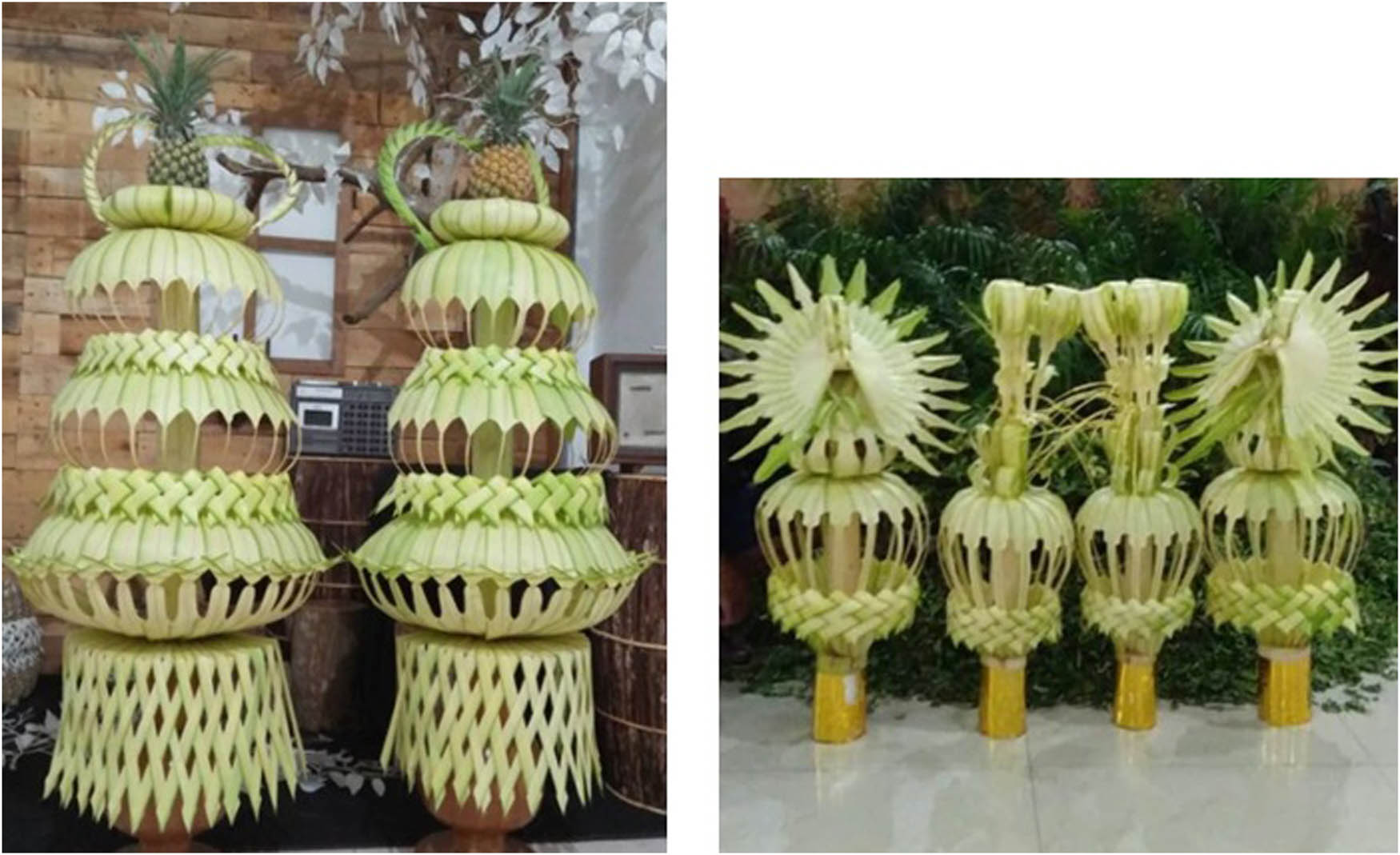
Kembar Mayang in marriage ceremony (Tenola, 2023).
Roncean is a technique of making disposable or decorative objects from flowers, beads, seeds, or other materials that are hollow or can be punched with a stitch tool so that they can be assembled as desired (Hidayati, 2012). Jasmine ronce is a flower arrangement that uses the basic ingredients of jasmine flowers arranged in such a way according to certain shapes and rules (Saryoto, 2012). Jasmine ronce is a decoration used by the bride and groom. Jasmine flowers symbolize purity, chastity, simplicity, and beauty. Based on the purity of the heart in marriage, the bride, and groom try to reject all dangers that will attack themselves and their family members (Slamet et al., 1990). In addition, the jasmine ronce symbolizes the harmony of married life (Khofifah & Faidah, 2013). Both partners have their respective duties and obligations in the course of marriage so that there is a bond that protects and looks after each other until the end of life. It is a human who lives through the cycle of birth–marriage–death (Jazeri, 2020) (Figure 2).

Ronce jasmine (Pusatnya ronce melati Solo, 2023).
3.2 Creation of Batik Motifs and Patterns
Batik motif design is a materialized work that can be touched and held, which means batik work is an object (Sartika et al., 2017). Meanwhile, the beauty of batik works cannot be separated from the shape or visual elements and colors that make batik works can be seen and enjoyed. Traditional batik motifs consist of repeating units in all directions, becoming a unified motif (Susanto, 1973). Based on the observations made, the Kembar Mayang and ronce motifs are arranged as follows (Figures 3–5).
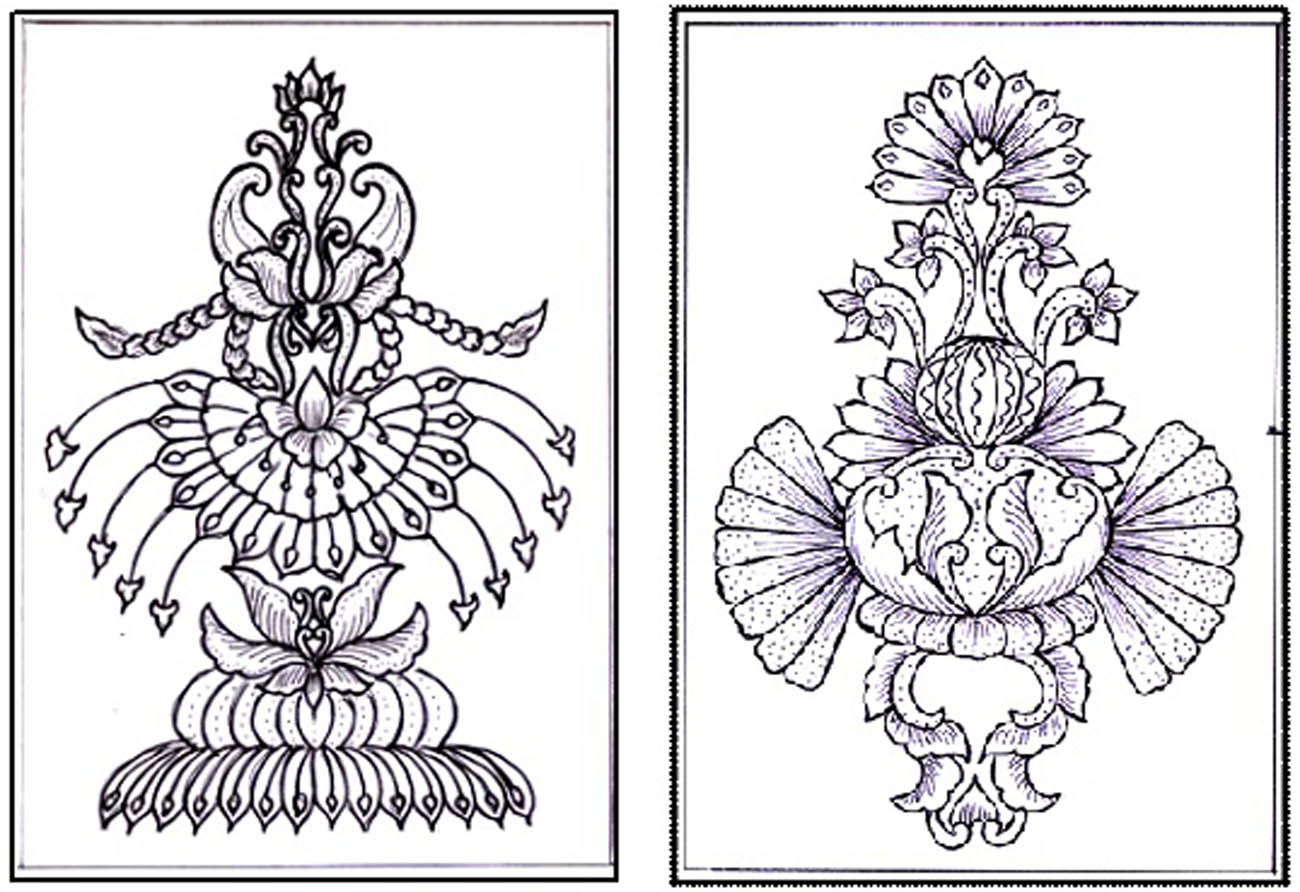
Motif of Kembar Mayang (author’s illustration).

Motif of ronce (author’s illustration).
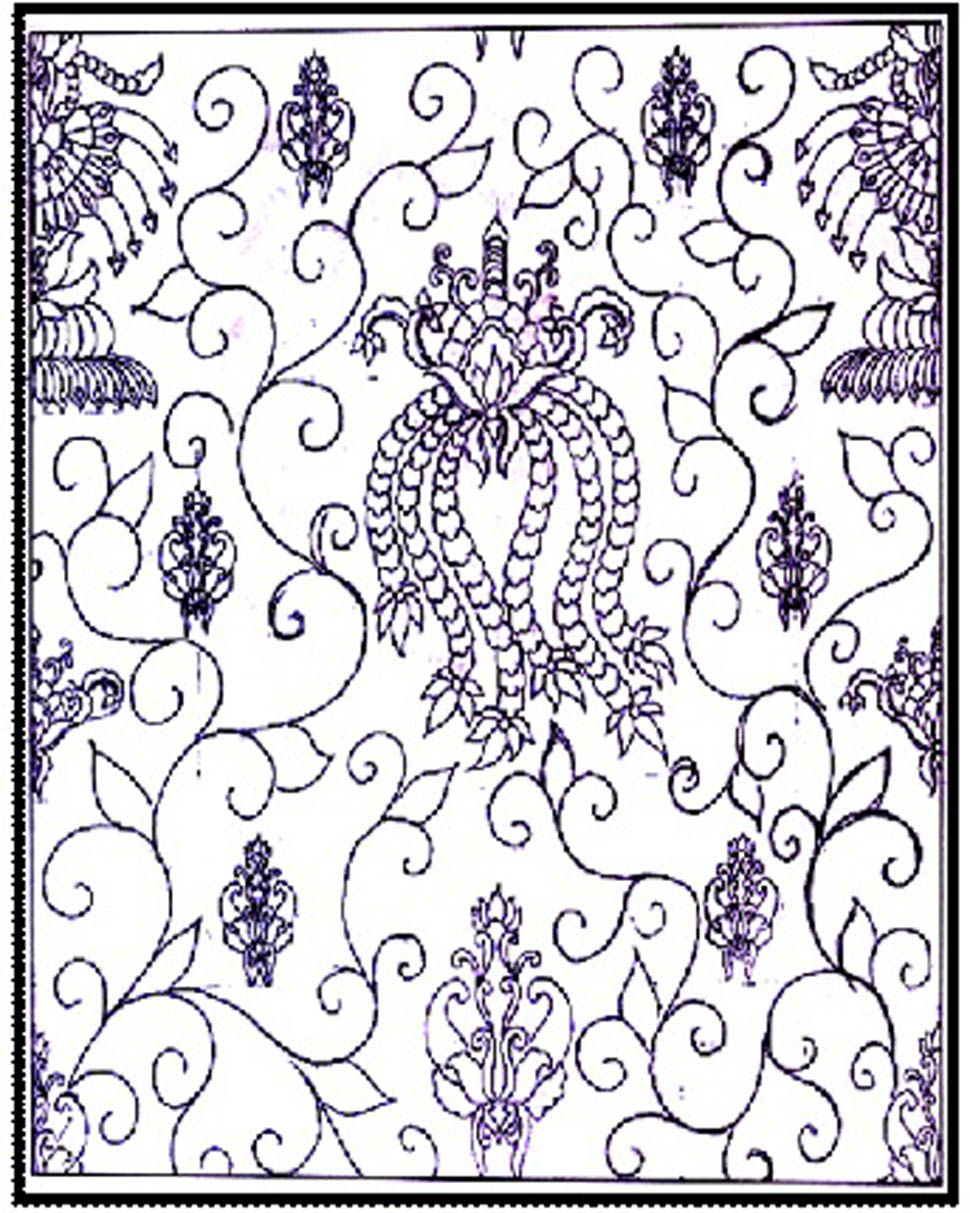
Batik patterns of Kembar Mayang and ronce (author’s illustration).
In batik creation, the term pattern is a continuation of the motif or a combination of motifs, if the motif is repeated, it becomes a pattern.
3.3 Natural Dyes of Batik
The most obvious difference between synthetic dyes (factory-made) and natural dyes is that the intensity is different. Factory-made dyes are more striking, while the characteristics of natural dyes are softer in color. In 1996, the Netherlands in a CBI (Center for Promotion of Imports from Devolving Countries) letter decided to ban synthetic (factory-made) batik dyes from being exported there (Sunarya, 2012b). This decision was followed by other countries such as America, Germany, Malaysia, and Japan. The decision was based on the impact of synthetic dyes that can damage the environment (Tangahu et al., 2019), and synthetic dyes containing Azo groups (Naphtol, Rapid, and Direk) can cause cancer (Kant, 2012). There are also other health risks such as allergies and skin injury (Zhang et al., 2012). The method of chemical indigo dye abstraction results in things that are less beneficial to the user’s body (Sudiatso, 1999).
In recent years, domestically and abroad, the revival of natural dyes has become one of the solutions to reduce the impact of environmental pollution (Sobandi et al., 2021). Natural dyes have been used in batik coloring in Indonesia long before chemical dyes existed, namely 1856, a cultural wealth that has been lost, forgotten, or even driven by false pragmatic needs (Sunarya, 2006). Indeed, there are some disadvantages to using natural dyes. The weakness in natural color dyeing is that dyeing takes a long process, 20–30 times, and some even soak for 20 days. It also may fade quickly and the quality may not be as consistent as synthetic dyes (Affat, 2021). Even so, there have been several studies on the development of natural dyes that are assisted by fixation to strengthen the color, such as using fixation of bone ash (Bahari et al., 2020), ferrous sulfate (Sobandi et al., 2023), lime solution (Sobandi et al., 2021), cationic dye-fixing agent (Hossain et al., 2022), and so on. The use of natural dyes no longer has significant disadvantages as before; therefore, the promotion of the use of natural batik dyes has begun.
Natural dyes are suitable for the environment due to their non-toxic characteristics and result in soft and delicate colors. Classification of natural dyes based on their source comes from flora, fauna, micro-organisms, and minerals (Adeel et al., 2018). One of the things that is easily found in Indonesia is flora. Parts of plants that can be used for natural dyes vary, such as leaves, trunks, flowers, roots, and so on. Leaves are one part of the plant that has the potential to be a reliable source of natural dyes. There have been many studies on natural dyes from leaves that produce beautiful colors (Singh & Srivastava, 2017; Sunarya, 2006).
3.4 Keji Beling (Strobilanthes crispus)
Strobilanthes crispus, a shrub of the Acanthaceae family, is naturally found in Madagascar and the Malay Archipelago including Indonesia. This plant is commonly referred to as “enyoh kelo,” “keci beling,” “pecah beling,” “pecah kaca,” “keji biling,” “lidah jin,” atau “jin batu” (Sunarto, 1977). The place where this plant grows is usually along rivers or in vacant uninhabited fields (Noraida, 2005). Keji Beling grows from 50 to 1,200 m above sea level. It also easily reproduces in fertile soil, somewhat sheltered, and open places. In Java, this plant is commonly found in rural areas growing as a shrub. It is propagated by seeds and cuttings (Yayasan Kehati, 2015).
This plant is a popular source of natural dyes that produce indigo color (Kurniawan et al., 2021). Keji beling is useful not only as a source of natural indigo color for batik dyes, but also as a medicinal plant. The plant has a high vitamin and mineral content as well as phytochemicals that provide therapeutic effects (Ng et al., 2021; Yu et al., 2021) (Figure 6).
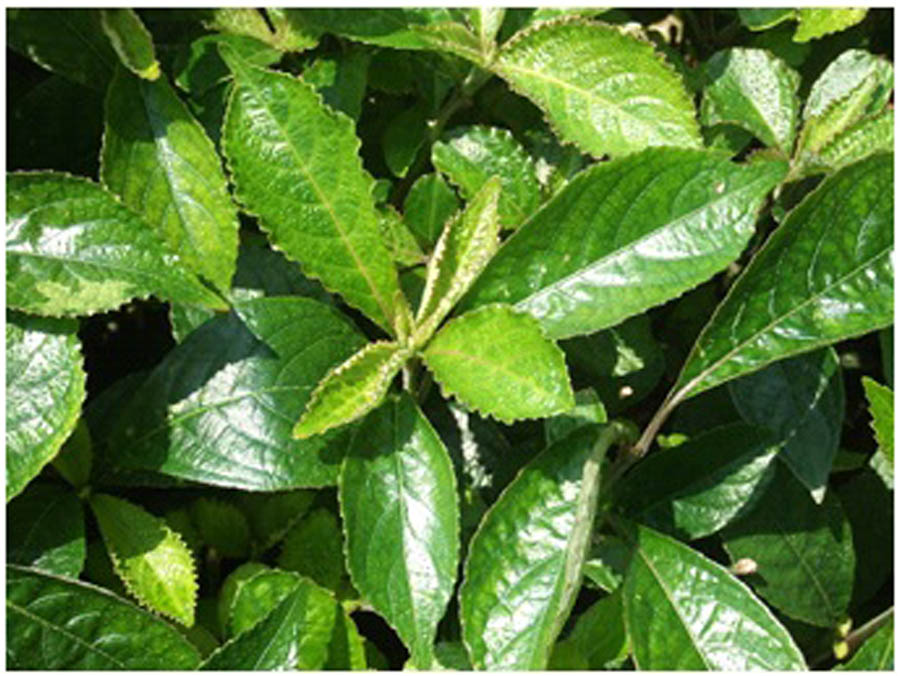
Leaf of Keci Beling (Strobilanthes crispus) (Kamijara Wulung, 2013).
The raw materials used include 1 kg of keji beling (Strobilanthes crispus) leaves and vinegar water used as fixation. The natural dye of keji beling leaves is obtained from 1 kg plus 8 l of water boiled for 1 h (until simmering), left overnight, and then filtered. The natural dye of indigo color natural dye from keji beling leaves is ready to use.
3.5 Mango (Mangifera indica L.)
Mango (Mangifera indica L.) is a tropical fruit species that is easily recognizable worldwide for its production, distribution, marketing, and use. The use of mangoes for natural batik dyes is well known, starting from the leaves (Uddin, 2015), fruit peel (Bains et al., 2003), and many other parts of the mango tree (Ayele et al., 2020). One of the most popular types of mangoes in Indonesia is the honey mango, given its name because the fruit is as sweet as honey.
The raw materials to get an extraction of honey mango leaves are 1 kg of honey mango (Mangifera indica L.) leaves and tawas/alum (Al2(SO4)3·K2SO4·24H2O) used as fixation. The natural dye of honey mango leaves is obtained from 1 kg plus 8 l of water boiled for 1 h (until simmering), left overnight, and then filtered. The natural dye of honey mango leaves is ready to use (Figure 7).
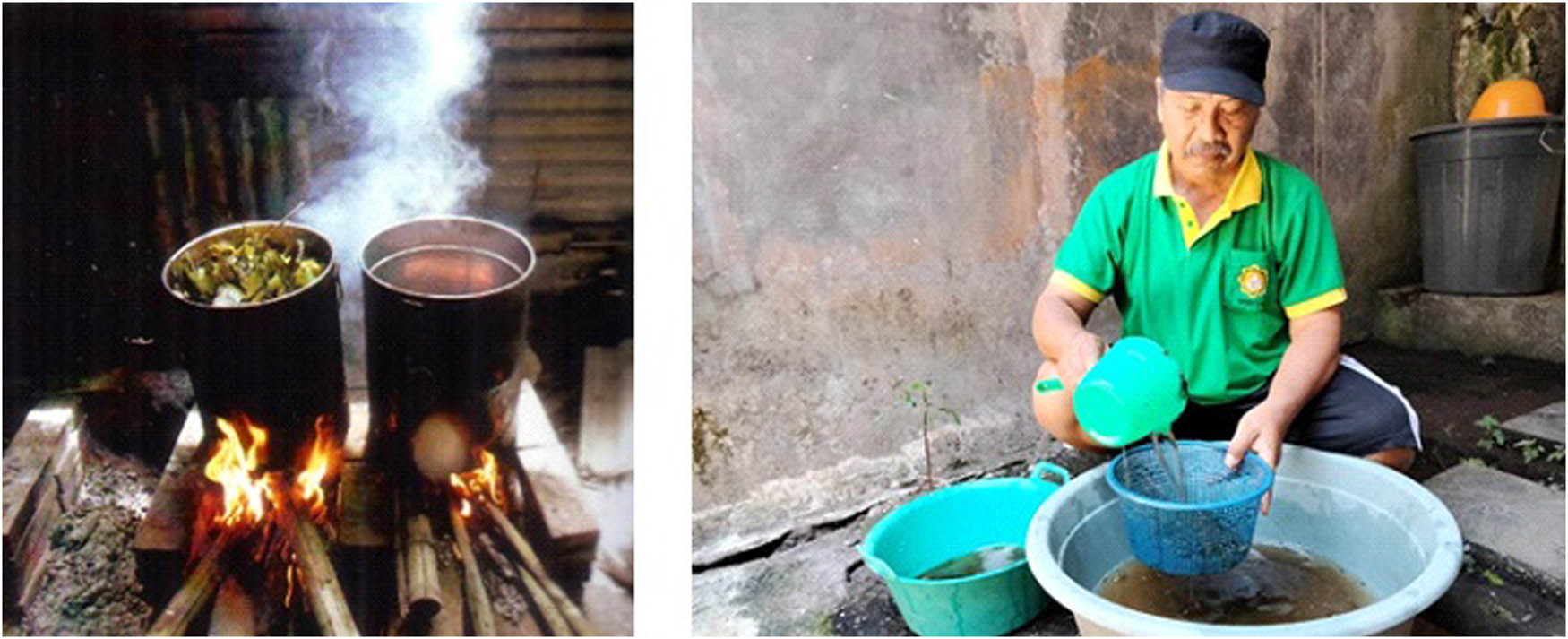
Boiling and filtering of natural dye materials (author’s documentation).
3.6 Batik-Making Process
Batik has been recognized worldwide as a traditional Indonesian fabric. Batik is a typical Javanese fabric of resist printing process, where molten wax is poured over the pattern before coloring, leaving the wax part untouched in the coloring (Barve, 1967).
The first stage is fabric preparation by mordanting the fabric. The main function of the mordant is to increase the ability of natural dyes to stick, remove other components that are attached, fastness, and produce evenness of natural dye staining and color sharpness. To perform the mordanting process, several chemical substances are needed as mordants. Some substances used as mordants include soda ash (Na2CO3), tawas (Al2(SO4)3·K2SO4·24H2O) dan TRO. The mordanting recipe for 500 g of cotton fabric is to soak the fabric in a solution of 2 g of TRO/liter of water and leave it overnight; then, wash it thoroughly. Next, and boil the fabric in water containing 100 g of alum in soda ash (30 g) for 1 h. The fabric is soaked for one night or 12 h and then finally left to dry; the fabric is ready to be patterned.
And then, the next stage is fabric patterning. Patterning is the process of transferring the pattern image to the fabric, and the patterning process is traced. The pattern in Figure 5 is plotted on the fabric (Figure 8).

Tracing pattern on fabric (author’s documentation).
The next stage is mencanting or waxing; waxing is incising the wax (malam) into the fabric with a tool in the form of canting tulis. There is a type of canting technique, namely canting tulis, the process is more free, just like writing on a cloth with canting tulis full of wax. It has incised the wax according to the motif that has been prepared or the concept that has been made. The second type of canting is the canting cap. The process is bound by the motif on the stamp. The advantages are faster than drawing with canting tulis, but the results are monotone or by the motif image on the stamp tool, which is repeated in such a way. The third is a mixed technique, namely writing and stamping. This research uses the canting tulis technique with the following results (Figure 9).
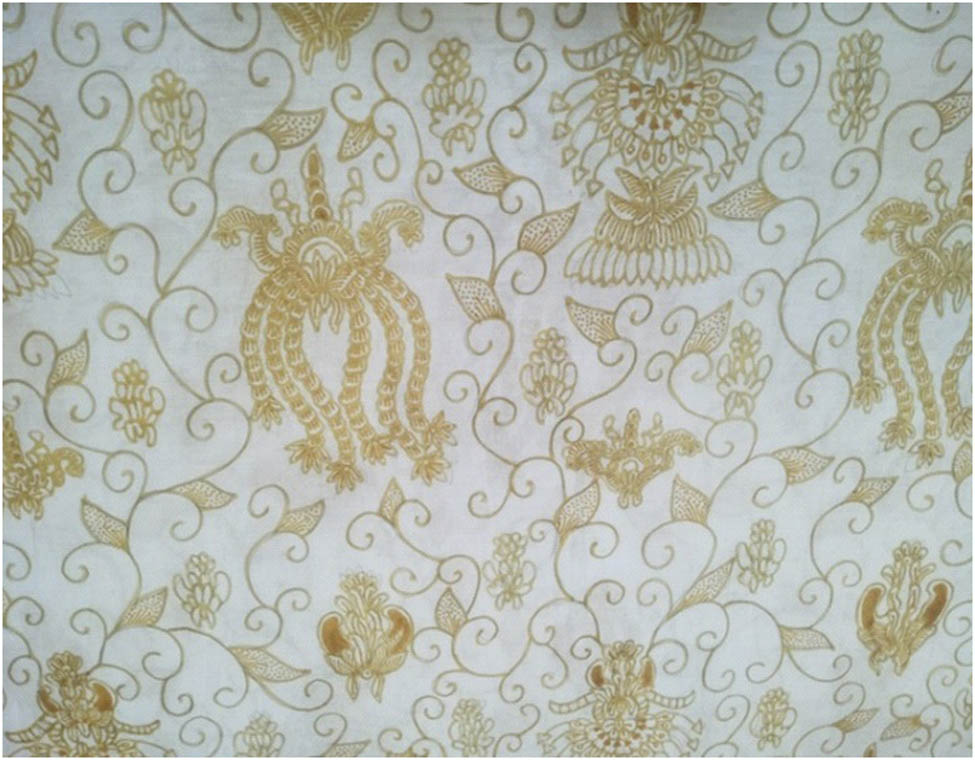
The fabric has been waxed according to the pattern (author’s documentation).
The next step is the color dyeing process. First, the fabric was dipped ten times in the natural dye of keji beling (Strobilanthes crispus) that had been prepared previously. Each time, after the fabric was evenly dipped, the fabric was left to dry first. Then, the process is repeated ten times. This multiple dyeing is to obtain a dense and thick fabric color. After ten repetitions of this step, the fabric is dried and fixed with vinegar (Figure 10).
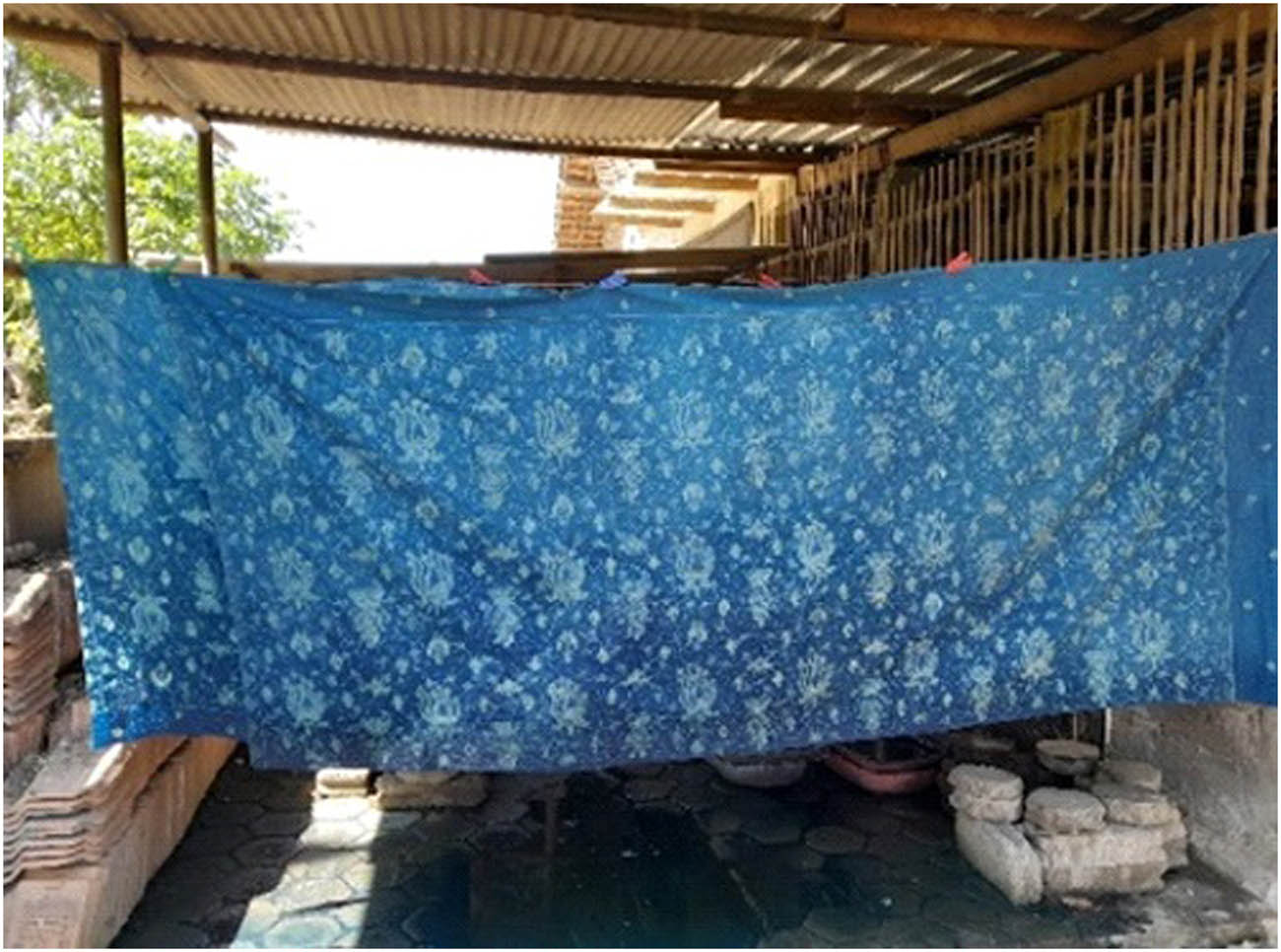
The fabric is left to dry after being dyed with keji beling natural dyes (author’s documentation).
Then, the next stage is the second coloring process with honey mango leaf natural dye. The stages are the same as the previous stage. The fabric was dipped in honey mango natural dye ten times. Each time, after dyeing evenly, the fabric is left to dry. The process was carried out ten times, after which the fabric was dried and fixed with tawas/alum (Al2(SO4)3·K2SO4·24H2O) (Figure 11).
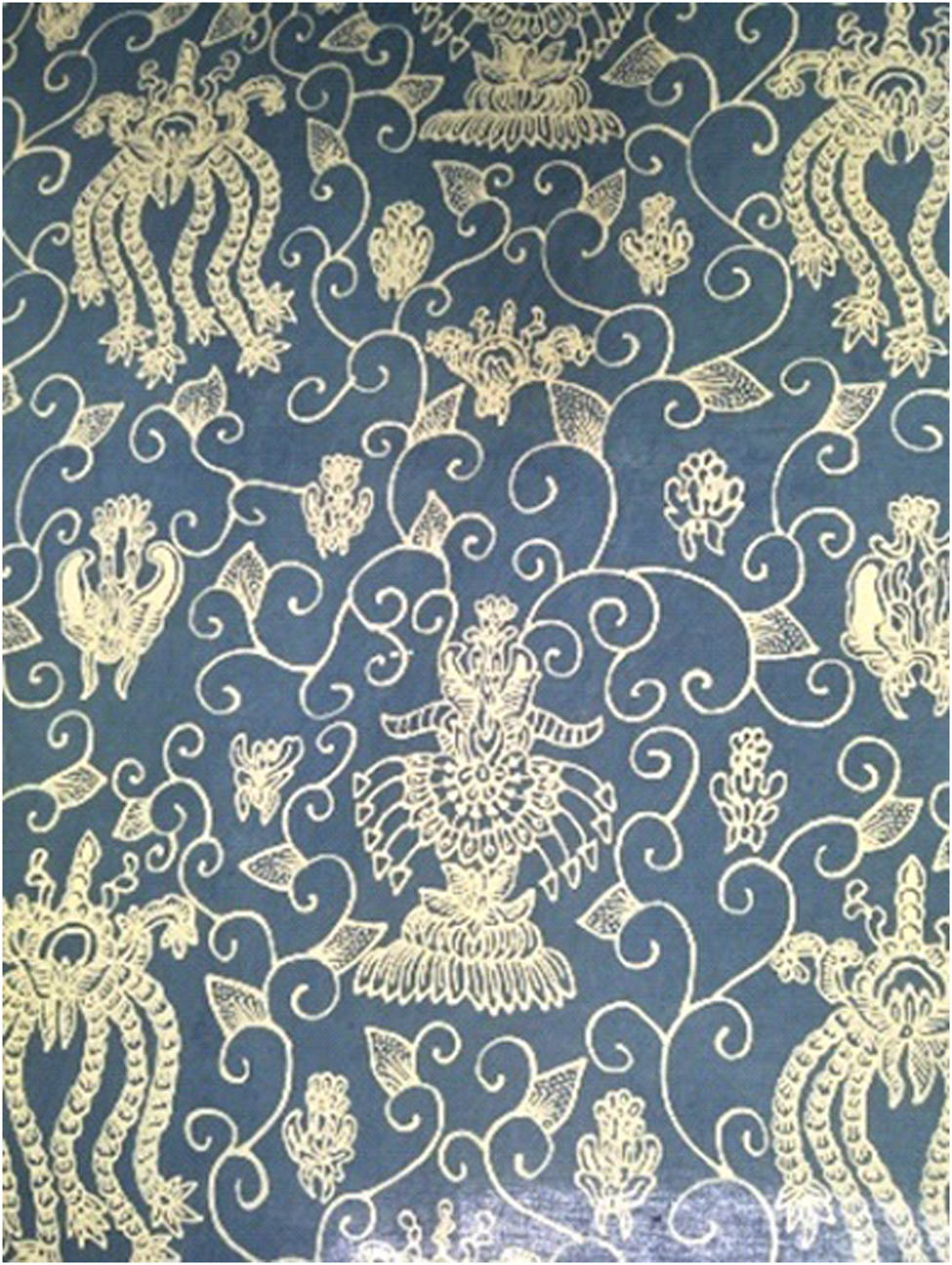
Fabric dyed with natural dyes of keci beling leaves and honey mango leaves (author’s documentation).
3.7 Testing
At this stage, the author analyzes and interprets the data obtained from the laboratory test results. Tests carried out on the batik with natural dyes keji beling leaves and honey mango leaves are resistant to iron heat and soap washing. The tests were carried out at the Textile Manufacturing and Testing Laboratory, Textile Engineering Study Program, Faculty of Industrial Technology, Universitas Islam Indonesia, Yogyakarta, Indonesia. The results show that the color of batik with natural dyes keji beling leaves and honey mango leaves is strong against the soap washing resistance test with level 4, which is good. Then, the color on the batik cloth also got a good score on the iron heat resistance test, namely 4–5. Therefore, it can be concluded that the natural dyes of keji beling leaves and honey mango leaves have good resistance to soap washing and hot ironing.
4 Conclusion
Based on the previous discussion, batik with Kembar Mayang and ronce motifs using natural dyes of keji beling leaves and mango honey leaves is suitable for use as formal wedding attire. Therefore, it is a batik that is worth developing. The Kembar Mayang and ronce motifs are interpretations of cultural objects that are always and must be present in Javanese traditional wedding ceremonies. Kembar Mayang means the same flower and is a symbol of the eternity of the love of the bride and groom. Meanwhile, the meaning of ronce is the bond between the two that forms harmony. The jasmine used to make the ronce is a symbol of purity and repels evil. Furthermore, the natural dyes of keci beling leaves and honey mango leaves are an effort to preserve nature and reduce water pollution. The color that emerges from the combination of these natural dyes is turquoise blue as the base and bright yellow in the pattern. It is a beautiful color for formal wedding attire.
Acknowledgment
The authors would like to express their deepest gratitude to the Rector of Universitas Negeri Yogyakarta who has funded the writing of this article based on the 2023 Assignment Research.
-
Funding information: The authors disclosed receipt of the following financial support for the research, authorship, and/or publication of this article: This work was supported and funded by the Universitas Negeri Yogyakarta with Penelitian Penugasan Year 2023 (01-06/UN.34/SPK/KU/2023).
-
Author contributions: All authors have accepted responsibility for the entire content of this manuscript and approved its submission. IKS, II, and WW designed the research. Then, all authors (IKS, II, WW, NKD, and IWNF) carried them out. IKS prepared the manuscript with contributions from all co-authors.
-
Conflict of interest: The authors declared no potential conflicts of interest concerning the research, authorship, and/or publication of this article.
-
Data availability statement: Data sharing is not applicable to this article as no datasets were generated or analysed during the current study.
References
Adeel, S., Rafi, S., Mustaan, M. A., Salman, M., & Ghaffar, A. (2018). Animal based natural dyes: A short review. In M. Yusuf (Ed.), Handbook of renewable materials for coloration and finishing (pp. 41–74). Scrivener Publishing LLC. doi: 10.1002/9781119407850.ch4.Search in Google Scholar
Affat, S. S. (2021). Classifications, advantages, disadvantages, toxicity effects of natural and synthetic dyes: A review. University of Thi-Qar Journal of Science, 8(1), 130–135.Search in Google Scholar
Ayele, M., Tesfaye, T., Alemu, D., Limeneh, M., & Sithole, B. (2020). Natural dyeing of cotton fabric with extracts from mango tree: A step towards sustainable dyeing. Sustainable Chemistry and Pharmacy, 17, 100293. doi: 10.1016/j.scp.2020.100293.Search in Google Scholar
Bahari, N., Handayani, R., Santoso, R. E., & Prameswari, N. S. (2020). Mordant and fixation test of bone ash on natural colours towards cotton and silk fabric. Vlakna a Textil, 27(4), 8–16.Search in Google Scholar
Bains, S., Singh, O. P., Goraya, G., & Kang, M. (2003). Dyeing of cotton with mango (Mangifera indica) dye. Journal of the Textile Association, 64(1), 23–26.Search in Google Scholar
Barve, V. R. (1967). Complete textile encyclopedia. Taraporevala Sons & Co. Private Ltd.Search in Google Scholar
Breliana, S. A., Budiono, H., & Widiatmoko, S. (2023). Simbolisme kembar mayang dalam pernikahan Adat Jawa di Kabupaten Kediri. Prosiding SEMDIKJAR (Seminar Nasional Pendidikan dan Pembelajaran), 6, 662–670. https://proceeding.unpkediri.ac.id/index.php/semdikjar/article/view/3717.Search in Google Scholar
Broadbent, A. D. (2001). Basic principles of textile coloration. Society of Dyers and Colourists.Search in Google Scholar
Endraswara, S. (2018). Falsafah hidup Jawa. Cakrawala.Search in Google Scholar
Fanjalu, A. M. F., & Rukmini, B. S. (2022). Kajian nilai-nilai tradisi Kembar Mayang dalam prosesi pernikahan. Bakaba, 10(1), 33–42. doi: 10.22202/bakaba.2022.v10i1.5864.Search in Google Scholar
Febriana, S. A., Erdina, Dewi, K., Ridora, Y., Anggraeni, A., Indrastuti, N., Waskito, F., Oginawati, K., Tanziha, I., & Prakoeswa, C. R. S. (2023). Risk factors of occupational skin diseases among traditional batik manufacturing workers in Yogyakarta, Indonesia. BMC Research Notes, 16(1), 1–6. doi: 10.1186/s13104-022-06105-0.Search in Google Scholar
Febriani, R., Knippenberg, L., & Aarts, N. (2023). The making of a national icon: Narratives of batik in Indonesia. Cogent Arts and Humanities, 10(1), 1–16. doi: 10.1080/23311983.2023.2254042.Search in Google Scholar
Groeneveld, I., Pirok, B. W. J., Molenaar, S. R. A., Schoenmakers, P. J., & van Bommel, M. R. (2022). The development of a generic analysis method for natural and synthetic dyes by ultra-high-pressure liquid chromatography with photo-diode-array detection and triethylamine as an ion-pairing agent. Journal of Chromatography A, 1673, 463038. doi: 10.1016/j.chroma.2022.463038.Search in Google Scholar
Gustami, S. P. (2007). Butir-butir mutiara estetika Timur, ide dasar penciptaan seni kriya Indonesia. Prasista.Search in Google Scholar
Hemas, G. K. R. (2000). Tekstil kerajinan Indonesia: Seni rakyat dan potensinya dalam perekonomian rakyat. Makalah dan Lokakarya. Dewan Kerajinan Nasional DIY.Search in Google Scholar
Hendriyana, H. (2022). Meaning differences in indigenous kriya and crafts in Indonesia and their leverage on the craft of science globally. Harmonia: Journal of Arts Research and Education, 22(2), 337–354. doi: 10.15294/harmonia.v22i2.36567.Search in Google Scholar
Hidayati, R. (2012). Modifikasi tata rias pengantin Solo Putri dan Yogya Putri. Gramedia Pustaka Utama.Search in Google Scholar
Hossain, M. Y., Jiang, T., Zhu, W., Sarker, S., Pervez, M. N., Hoque, M. I. U., Cai, Y., & Naddeo, V. (2022). Green and sustainable method to improve fixation of a natural functional dye onto cotton fabric using cationic dye-fixing agent/D5 Microemulsion. Journal of Natural Fibers, 19(15), 11283–11298. doi: 10.1080/15440478.2021.2024933.Search in Google Scholar
Jazeri, M. (2020). Makna tata simbol dalam upacara pengantin Jawa. Akademia Pustaka.Search in Google Scholar
Juliani, A., Rahmawati, S., & Yoneda, M. (2021). Heavy metal characteristics of wastewater from batik industry in Yogyakarta area, Indonesia. International Journal of GEOMATE, 20(80), 59–67. doi: 10.21660/2021.80.6271.Search in Google Scholar
Kamijara Wulung. (2013). Tanaman pecah beling serta manfaatnya. http://kamijarawulung.blogspot.com/2013/01/tanaman-pecah-beling-serta-manfaatnya.html.Search in Google Scholar
Kant, R. (2012). Textile dyeing industry an environmental hazard. Natural Science, 4(1), 22–26. doi: 10.4236/ns.2012.41004.Search in Google Scholar
Khofifah, K., & Faidah, M. (2013). Karakteristik tata rias pengantin Solo. Jurnal Tata Rias, 2(2), 27–39.Search in Google Scholar
Kurniawan, C., Mahatmanti, F. W., Mahfudz, J., Qonita, U., Nugraha, R., & Bahron, H. (2021). Color and chemical oxygen demand removal of Strobilanthes cusia fermentation and natural indigo-based batik dyeing wastewater. International Journal of Research Innovation and Entrepreneurship, 2(1), 10–16. https://journal.unnes.ac.id/sju/index.php/ijrie/article/view/48688/20756.Search in Google Scholar
Kusumawati, N., Rahmadyanti, E., & Sianita, M. M. (2021). Batik became two sides of blade for the sustainable development in Indonesia. In S. K. Sharma (Ed.), Green chemistry and water remediation: Research and applications (pp. 59–97). Elsevier Inc. doi: 10.1016/B978-0-12-817742-6.00003-7.Search in Google Scholar
Lemmens, R. H. M. J., & Wulijarni-Soetjipto, N. (Eds.). (1992). Plant resource of South-East Asia: Dye and tannin-producing plants. Prosea Foundation.Search in Google Scholar
Mukimin, A., Vistanty, H., Zen, N., Purwanto, A., & Wicaksono, K. A. (2018). Performance of bioequalization-electrocatalytic integrated method for pollutants removal of hand-drawn batik wastewater. Journal of Water Process Engineering, 21, 77–83. doi: 10.1016/j.jwpe.2017.12.004.Search in Google Scholar
Mulyanto, M., Hartono, L., Murni, E. S., Handayani, E. S., & Nurcahyanti, D. (2022). Teak trees as source of inspiration for developing batik motifs. Harmonia: Journal of Arts Research and Education, 22(2), 241–253. doi: 10.15294/harmonia.v22i2.37874.Search in Google Scholar
Musman, A. (2017). Filosofi Rumah Jawa (N. Lestari, Ed.). Pustaka Jawi.Search in Google Scholar
Mutiara, A. (2023). 10 Besar negara pasar ekspor batik Indonesia, ada AS & Jepang. CNBC Indonesia. https://www.cnbcindonesia.com/research/20231002123159-128-477038/10-besar-negara-pasar-ekspor-batik-indonesia-ada-as-jepang.Search in Google Scholar
Ng, M. G., Ng, C. H., Ng, K. Y., Chye, S. M., Ling, A. P. K., & Koh, R. Y. (2021). Review anticancer properties of strobilanthes crispus: A review. Processes, 9(8), 1–18. doi: 10.3390/pr9081370.Search in Google Scholar
Noraida, A. (2005). Penyembuhan semula jadi dengan herba [Natural healing with herbs]. PTS Millennia Sdn. Bhd.Search in Google Scholar
Nugroho, Z. B., Cahyandito, M. F., Astari, A. J., Dede, M., Abdoellah, O. S., Fadilah, K., & Sunardi, S. (2022). Preliminary development of indicators for assessing the sustainability of Indonesia’s natural-dye-based batik industry. International Journal of Sustainable Development and Planning, 17(7), 2097–2107. doi: 10.18280/ijsdp.170710.Search in Google Scholar
Nurcahyanti, D., Mulyanto, & Sachari, A. (2021). The role of artisans in the batik designs development as a traditional textile in Indonesia. Vlakna a Textil, 28(2), 45–53.10.9734/arjass/2021/v15i330260Search in Google Scholar
Oktaviana, D. (2022). Kembar Mayang dalam upacara pernikahan masyarakat Jawa (tinjauan filosofis). Widya Katambung: Jurnal Fisalfat Agama Hindu, 13(1), 37–43. doi: 10.33363/wk.v13i1.821.Search in Google Scholar
Periyasamy, A. P. (2022). Natural dyeing of cellulose fibers using syzygium cumini fruit extracts and a bio-mordant: A step toward sustainable dyeing. Sustainable Materials and Technologies, 33, 1–9. doi: 10.1016/j.susmat.2022.e00472.Search in Google Scholar
Pramugani, A., Soda, S., & Argo, T. A. (2020). Current situation of batik wastewater treatment in Pekalongan City, Indonesia. Journal of Japan Society of Civil Engineers, 8(1), 188–193. doi: 10.2208/journalofjsce.8.1_188.Search in Google Scholar
Prasetyo, A. (2010). Batik Karya Agung Warisan Budaya Dunia. Pura Pustaka.Search in Google Scholar
Pusatnya ronce melati Solo. (2023). flower.weddingnya.solo. https://www.instagram.com/flower.weddingnya.solo/.Search in Google Scholar
Raman, C. D., & Kanmani, S. (2016). Textile dye degradation using nano zero valent iron: A review. Journal of Environmental Management, 177, 341–355. doi: 10.1016/j.jenvman.2016.04.034.Search in Google Scholar
Raya, A. B., Andiani, R., Siregar, A. P., Prasada, I. Y., Indana, F., Simbolon, T. G. Y., Kinasih, A. T., & Nugroho, A. D. (2021). Challenges, open innovation, and engagement theory at craft smes: Evidence from Indonesian batik. Journal of Open Innovation: Technology, Market, and Complexity, 7(2), 1–24. doi: 10.3390/joitmc7020121.Search in Google Scholar
Sarjiyanto, S., Gunaratne, M. S., & Firdaus, R. B. R. (2023). Sustainable industry, culture and community development: A case study of Kampung Batik Laweyan, Indonesia. Journal of Sustainability Science and Management, 18(1), 163–180. doi: 10.46754/jssm.2023.01.010.Search in Google Scholar
Sartika, D., Eskak, E., & Sunarya, I. K. (2017). Uma Lengge dalam kreasi batik Bima. Dinamika Kerajinan dan Batik: Majalah Ilmiah, 34(2), 73–82. doi: 10.22322/dkb.v34i2.3365.Search in Google Scholar
Saryoto, N. (2012). Tata rias pengantin dan adat istiadat pernikahan Surakarta klasik: Solo Puteri. Gramedia Pustaka Utama.Search in Google Scholar
Shahid, M., Ahmad, A., Yusuf, M., Khan, M. I., Khan, S. A., Manzoor, N., & Mohammad, F. (2012). Dyeing, fastness and antimicrobial properties of woolen yarns dyed with gallnut (Quercus infectoria Oliv.) extract. Dyes and Pigments, 95(1), 53–61. doi: 10.1016/j.dyepig.2012.03.029.Search in Google Scholar
Singh, R., & Srivastava, S. (2017). A critical review on extraction of natural dyes from leaves. International Journal of Home Science, 3(2), 100–103. https://www.homesciencejournal.com/archives/2017/vol3issue2/PartB/3-2-20.pdf.Search in Google Scholar
Slamet, P., Harsojo, H., Widyatmanto, D., & Erwono, M. (1990). Arti perlambangan dan fungsi tata rias pengantin dalam menanamkan nilai-nilai budaya daerah Jawa Tengah. Departemen Pendidikan dan Kebudayaan.Search in Google Scholar
Sobandi, B., Supiarza, H., Gunara, S., Gunawan, W., & Hamdani, H. Y. (2023). An eco-friendly dye for batik clothes: A natural dye solution made of mango seeds extract (Mangifera indica L.). Vlakna a Textil, 30(3), 37–47. doi: 10.15240/tul/008/2023-3-005.Search in Google Scholar
Sobandi, B., Triyanto, Rohidi, T. R., & Syakir. (2021). The use of clove leaves (syzygium aromaticum l.) as natural dye for batik production in kasumedangan batik industry, Indonesia. Vlakna a Textil, 28(1), 86–94.Search in Google Scholar
Sudiatso, S. (1999). Studi kultivsi tanaman tarum (Indigofera Arrecta Hochst). Makalah. Dekranas DIY.Search in Google Scholar
Sugiarto, E., Othman, A. N., & Triyanto, F. M. (2020). Regional icon motifs: Recent trends in indonesia’s batik fabric development. Vlakna a Textil, 27(1), 93–98.Search in Google Scholar
Sunarto, P. (1977). Penerbit Direktorat Jenderal Pengawasan Obat dan Makanan (1st ed.). Materia Medika Indonesia.Search in Google Scholar
Sunarya, I. K. (2006). Pemanfaatan zat warna alami dan tata keselarasan pada kerajinan batik sutera, serat nanas dan katun guna meningkatkan kualitas dan produktivitas. DIKTI.Search in Google Scholar
Sunarya, I. K. (2012a). Pendidikan tinggi seni berkarakter budaya adiluhung estafet generasi kreatif yang berkelanjutan. Jurnal Pendidikan Karakter, II(2), 179–188.10.21831/jpk.v0i2.1302Search in Google Scholar
Sunarya, I. K. (2012b). Zat warna alam alternatif warna batik yang menarik. Inotek, 16(2), 103–121.Search in Google Scholar
Sunarya, I. K. (2020a). The concept of Rwa Bhineda Kriya on the island of Bali towards Jagadhita. Wacana Seni, 19, 47–60. doi: 10.21315/ws2020.19.4.Search in Google Scholar
Sunarya, I. K. (2020b). The cross-conflict of kriya and crafts in Indonesia. Journal of Arts and Humanities, 9(10), 29–39. doi: 10.18533/JAH.V9I10.1994.Search in Google Scholar
Sunarya, I. K. (2021). Kriya Bebali in Bali: Its essence, symbolic, and aesthetic. Cogent Social Sciences, 7(1), 1–19. doi: 10.1080/23311886.2021.1882740.Search in Google Scholar
Sunarya, I. K. (2022). Kriya di Pulau Bali: Ketakson, kerajinan, dan kitsch. Jurnal Panggung, 32(1), 47–64.10.26742/panggung.v32i1.1728Search in Google Scholar
Suprapto, H. (2000). Penggunaan zat pewarna alami untuk batik. Batik Natural Color “BIXA”.Search in Google Scholar
Supriyadi, S., & Prameswari, N. S. (2022). The process of making batik and the development of Indonesian Bakaran motifs. Vlakna a Textil, 29(1), 63–72. doi: 10.15240/tul/008/2022-1-008.Search in Google Scholar
Susanto, S. S. K. (1973). Seni kerajinan batik Indonesia. Departemen Perindustrian RI.Search in Google Scholar
Syakir, S., Sobandi, B., Fathurrahman, M., Isa, B., Anggraheni, D., & Verayanti, S. (2022). Tamarind (Tamarindus indica L.): Source of ideas behind the Semarang batik motifs to strengthen local cultural identity. Harmonia: Journal of Arts Research and Education, 22(1), 78–90. doi: 10.15294/harmonia.v22i1.36579.Search in Google Scholar
Syamwil, R., Sugiarto, E., Rohidi, T. R., & Nurrohmah, S. (2019). Weeds as a source of development idea on batik motive. Vlakna a Textil, 26(2), 69–73.Search in Google Scholar
Syed Shaharuddin, S. I., Shamsuddin, M. S., Drahman, M. H., Hasan, Z., Mohd Asri, N. A., Nordin, A. A., & Shaffiar, N. M. (2021). A review on the Malaysian and Indonesian batik production, challenges, and innovations in the 21st century. SAGE Open, 11(3), 1–19. doi: 10.1177/21582440211040128.Search in Google Scholar
Tangahu, B. V., Ningsih, D. A., Kurniawan, S. B., & Imron, M. F. (2019). Study of BOD and COD removal in batik wastewater using Scirpus grossus and Iris pseudacorus with Intermittent Exposure System. Journal of Ecological Engineering, 20(5), 130–134. doi: 10.12911/22998993/105357.Search in Google Scholar
Tenola, D. (2023). Kembar mayang tidak diangkat: Arti, filosofi, hingga simbol gadis-perjaka. detikJatim. https://www.detik.com/jatim/berita/d-6814021/kembar-mayang-tidak-diangkat-arti-filosofi-hingga-simbol-gadis-perjaka.Search in Google Scholar
The Minister of Environment Decree No. 5, Concern of Various Industries Waste Water Standard. (2014). testimony of Ministry of Environment Republic of Indonesia.Search in Google Scholar
Tri, Y., & Nooryan, B. (2023). The development and analysis of eco-print and screen printing combination using natural dyes. Vlakna a Textil, 30(2), 51–55. doi: 10.15240/TUL/008/2023-2-006.Search in Google Scholar
Uddin, M. G. (2015). Extraction of eco-friendly natural dyes from mango leaves and their application on silk fabric. Textiles and Clothing Sustainability, 1(7), 1–8. doi: 10.1186/s40689-015-0007-9.Search in Google Scholar
UNESCO. (2009). Indonesian Batik. UNESCO. https://ich.unesco.org/en/RL/indonesian-batik-00170.Search in Google Scholar
Wacik, J. (2008). Strategi promosi batik di dalam dan luar negeri. Proceeding Seminar Nasional: Kebangkitan Batik Indonesia dengan Tema Batik di Mata Bangsa Indonesia dan Dunia.Search in Google Scholar
Widayati, S. (2008). Makna filosofis Kembar Mayang dalam kehidupan masyarakat Jawa. Jurnal Filsafat, 18(2), 115–129.Search in Google Scholar
Widiawati, D., & Arfan, N. (2020). Utilization of local resources for batik design development in Indonesia textile industry. Palarch’s Journal of Archaeology of Egypt/Egyptology, 17(4), 1609–1627.Search in Google Scholar
Yahya, A. (1991). Batik adiluhung tapi tersandung. Balai Perindustrian Batik Yogyakarta.Search in Google Scholar
Yayasan Kehati. (2015). Keji beling. https://biodiversitywarriors.kehati.or.id/artikel/keji-beling-strobilanthes-crispus-bl/.Search in Google Scholar
Yu, H., Li, T., Ran, Q., Huang, Q., & Wang, J. (2021). Strobilanthes cusia (Nees) Kuntze, a multifunctional traditional Chinese medicinal plant, and its herbal medicines: A comprehensive review. Journal of Ethnopharmacology, 265, 113325. doi: 10.1016/j.jep.2020.113325.Search in Google Scholar
Zhang, C., Chen, J., & Wen, Z. (2012). Assessment of policy alternatives and key technologies for energy conservation and water pollution reduction in China’s synthetic ammonia industry. Journal of Cleaner Production, 25, 96–105. doi: 10.1016/j.jclepro.2011.11.056.Search in Google Scholar
© 2025 the author(s), published by De Gruyter
This work is licensed under the Creative Commons Attribution 4.0 International License.
Articles in the same Issue
- Special Issue: Designing the Feminist City: Projects, Practices, Processes for Urban Public Spaces, edited by Cecilia De Marinis (BAU College of Arts and Design of Barcelona, Spain) and Dorotea Ottaviani (University of Sapienza, Italy)
- Feminist Urban Paideias: The Need for New Imaginaries of the Aesthetic Walk
- Intervening “City Horses”: Soft Performative Gestures of Protest in Public Space
- Special Issue: Violence(s), edited by Carolina Borda (NHS Scotland) and Cristina Basso
- “He Who Obeys Does Not Err”: Examining Residual Violence in the Practice of Obedience Within the Catholic Church Through a Case Study of the Capuchin Order
- “Violent Possible”: The Stochasticity of Institutional Violence
- Stepping Out of Line: Moving Through Vulnerability With Children in Transition
- Autoethnographic Enquiry of Sexual Violence in Academia
- Towards a Reparatory Theory of Creolization
- Special Issue: Challenging Nihilism: An Exploration of Culture and Hope, edited by Juan A. Tarancón (University of Zaragoza)
- Ecological Grief, Hope, and Creative Forms of Resilience: A Creative Practice Approach
- Longing for the Past and Resisting Oblivion: Palestinian Women as Guardians of Memory in Bye Bye Tiberias (2023)
- Research Articles
- A Socio-Historical Mapping of Translation Fields: A Case Study of English Self-Help Literature in Arabic Translation
- Interaction of Linguistic and Literary Aspects in the Context of the Cultural Diversity of the Turkic Peoples of Central Asia
- Challenges and Strategies of Translating Arabic Novels into English: Evidence from Al-Sanousi’s Fiʾrān Ummī Hissa
- Persuasion Strategies in Facebook Health Communication: A Comparative Study between Egypt and the United Kingdom
- Digital Games as Safe Places: The Case of Animal Crossing
- Traditional Metaphors of Indonesian Women’s Beauty
- Evaluation of Translatability of Pun in Audio-Visual Content: The Case of Shark Tale
- Bovarism’s Neurotic Reflections Across Cultures: A Comparative Literary Case Study in Light of Karen Horney’s Neurosis Theory
- Flower Representations in the Lyrics of A.A. Fet
- Kembar Mayang and Ronce as Motif Ideas in Natural Dye Batik of Keci Beling Leaves and Honey Mango Leaves
- The Transformation of Kazakhstan’s National Classics in World Performing Arts
- Congratulation Strategies of Crown Prince Hussein’s Wedding: A Socio-pragmatic Study of Facebook Comments
- New Model of Contemporary Kazakh Cinema – Artstream: Trends and Paradigms
- Implementation of the Alash Idea in Literary Translations (On the Example of Contemporary Kazakh Literature)
- Transformations of the Contemporary Art Practices in the Context of Metamodern Sensibility
- Tracing the Flâneur: The Intertextual Origins of an Emblematic Figure of Modernity
- The Role of Media in Building Social Tolerance in Kyrgyzstan’s Ethno-Cultural Diversity
- Persuading in Arabic and English: A Study of EFL Argumentative Writing in Contrast with Native English Norms
- Refusal Strategies in Emirati Arabic: A Gender-Based Study
- Urban Indonesian Women and Fandom Identity in K-drama Fans on Social Media
- Linguistic and Translational Errors on Bilingual Public Signs in the Saudi Southern Region: A Linguistic Landscape Study
- Analyzing the Pragmatic Functions of the Religious Expression /ʔallaːh yaʕtiːk ʔilʕaːfje/(May God grant you health) in Spoken Jordanian Arabic
- “Geographical Imaginaries”: A Three-Decade Literature Review of Usage and Applications Across Academic Contexts
- Colonial Mimicry, Modernist Experimentation, and the Hegelian Dialectics of Empire: A Postcolonial Deconstructive Reading of Joseph Conrad’s Heart of Darkness
- Aesthetic Hybridization in the Creation of Contemporary Batik Motif Design
- Echoes of Past and Voices of Present: Intergenerational Trauma and Collective Memory in “The Fortune Men”
- Staging the Self: Life-Writings of Fatima Rushdi and Sarah Bernhardt as Emblems of Fin-de-Siècle New Womanhood
- Bodies and Things: Technology and Violence as a Vehicle for Posthumanist Ontologies in Julia Ducournau’s Titane
- Narrating the Ruins: Eco-Orientalism, Environmental Violence, and Postcolonial Ecologies in Arab Anglophone Fiction
Articles in the same Issue
- Special Issue: Designing the Feminist City: Projects, Practices, Processes for Urban Public Spaces, edited by Cecilia De Marinis (BAU College of Arts and Design of Barcelona, Spain) and Dorotea Ottaviani (University of Sapienza, Italy)
- Feminist Urban Paideias: The Need for New Imaginaries of the Aesthetic Walk
- Intervening “City Horses”: Soft Performative Gestures of Protest in Public Space
- Special Issue: Violence(s), edited by Carolina Borda (NHS Scotland) and Cristina Basso
- “He Who Obeys Does Not Err”: Examining Residual Violence in the Practice of Obedience Within the Catholic Church Through a Case Study of the Capuchin Order
- “Violent Possible”: The Stochasticity of Institutional Violence
- Stepping Out of Line: Moving Through Vulnerability With Children in Transition
- Autoethnographic Enquiry of Sexual Violence in Academia
- Towards a Reparatory Theory of Creolization
- Special Issue: Challenging Nihilism: An Exploration of Culture and Hope, edited by Juan A. Tarancón (University of Zaragoza)
- Ecological Grief, Hope, and Creative Forms of Resilience: A Creative Practice Approach
- Longing for the Past and Resisting Oblivion: Palestinian Women as Guardians of Memory in Bye Bye Tiberias (2023)
- Research Articles
- A Socio-Historical Mapping of Translation Fields: A Case Study of English Self-Help Literature in Arabic Translation
- Interaction of Linguistic and Literary Aspects in the Context of the Cultural Diversity of the Turkic Peoples of Central Asia
- Challenges and Strategies of Translating Arabic Novels into English: Evidence from Al-Sanousi’s Fiʾrān Ummī Hissa
- Persuasion Strategies in Facebook Health Communication: A Comparative Study between Egypt and the United Kingdom
- Digital Games as Safe Places: The Case of Animal Crossing
- Traditional Metaphors of Indonesian Women’s Beauty
- Evaluation of Translatability of Pun in Audio-Visual Content: The Case of Shark Tale
- Bovarism’s Neurotic Reflections Across Cultures: A Comparative Literary Case Study in Light of Karen Horney’s Neurosis Theory
- Flower Representations in the Lyrics of A.A. Fet
- Kembar Mayang and Ronce as Motif Ideas in Natural Dye Batik of Keci Beling Leaves and Honey Mango Leaves
- The Transformation of Kazakhstan’s National Classics in World Performing Arts
- Congratulation Strategies of Crown Prince Hussein’s Wedding: A Socio-pragmatic Study of Facebook Comments
- New Model of Contemporary Kazakh Cinema – Artstream: Trends and Paradigms
- Implementation of the Alash Idea in Literary Translations (On the Example of Contemporary Kazakh Literature)
- Transformations of the Contemporary Art Practices in the Context of Metamodern Sensibility
- Tracing the Flâneur: The Intertextual Origins of an Emblematic Figure of Modernity
- The Role of Media in Building Social Tolerance in Kyrgyzstan’s Ethno-Cultural Diversity
- Persuading in Arabic and English: A Study of EFL Argumentative Writing in Contrast with Native English Norms
- Refusal Strategies in Emirati Arabic: A Gender-Based Study
- Urban Indonesian Women and Fandom Identity in K-drama Fans on Social Media
- Linguistic and Translational Errors on Bilingual Public Signs in the Saudi Southern Region: A Linguistic Landscape Study
- Analyzing the Pragmatic Functions of the Religious Expression /ʔallaːh yaʕtiːk ʔilʕaːfje/(May God grant you health) in Spoken Jordanian Arabic
- “Geographical Imaginaries”: A Three-Decade Literature Review of Usage and Applications Across Academic Contexts
- Colonial Mimicry, Modernist Experimentation, and the Hegelian Dialectics of Empire: A Postcolonial Deconstructive Reading of Joseph Conrad’s Heart of Darkness
- Aesthetic Hybridization in the Creation of Contemporary Batik Motif Design
- Echoes of Past and Voices of Present: Intergenerational Trauma and Collective Memory in “The Fortune Men”
- Staging the Self: Life-Writings of Fatima Rushdi and Sarah Bernhardt as Emblems of Fin-de-Siècle New Womanhood
- Bodies and Things: Technology and Violence as a Vehicle for Posthumanist Ontologies in Julia Ducournau’s Titane
- Narrating the Ruins: Eco-Orientalism, Environmental Violence, and Postcolonial Ecologies in Arab Anglophone Fiction


